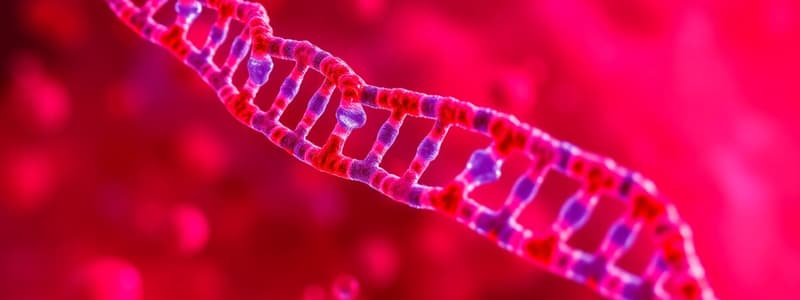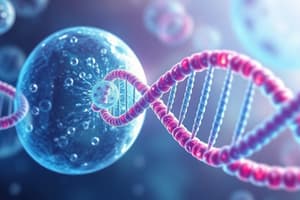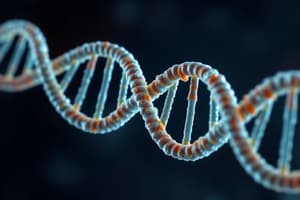Podcast
Questions and Answers
Given an in-frame deletion mutation that removes three consecutive codons within the coding sequence of a gene, what is the most probable functional consequence at the protein level, assuming cellular proofreading mechanisms are functional but not perfect?
Given an in-frame deletion mutation that removes three consecutive codons within the coding sequence of a gene, what is the most probable functional consequence at the protein level, assuming cellular proofreading mechanisms are functional but not perfect?
- A protein lacking three amino acids, but otherwise possessing a near-native conformation, potentially exhibiting altered but not necessarily abolished activity.
- A truncated protein due to the introduction of premature stop codons during attempted translational frameshifting. (correct)
- A protein with three additional amino acids inserted within its sequence due to frameshift correction.
- Complete degradation of the mRNA transcript via nonsense-mediated decay, preventing any protein production.
In the context of DNA replication fidelity, if a cell's DNA polymerase exhibits a significantly reduced exonuclease activity, which of the following outcomes is MOST likely?
In the context of DNA replication fidelity, if a cell's DNA polymerase exhibits a significantly reduced exonuclease activity, which of the following outcomes is MOST likely?
- A higher proportion of successful DNA replication events, as the polymerase is less likely to excise correctly incorporated nucleotides. (correct)
- An increased mutation rate due to the incorporation of non-complementary nucleotides that remain uncorrected.
- No significant change in the mutation rate, provided that DNA ligase activity is upregulated to compensate for polymerase errors.
- A decreased rate of DNA replication, as the polymerase stalls more frequently at mismatched base pairs.
Consider a scenario in which a novel compound selectively inhibits the activation of RNA nucleotides by preventing the addition of phosphate radicals. What immediate effect would this compound have on gene expression?
Consider a scenario in which a novel compound selectively inhibits the activation of RNA nucleotides by preventing the addition of phosphate radicals. What immediate effect would this compound have on gene expression?
- Translation would be upregulated as mRNA stability increases in the absence of new RNA synthesis. (correct)
- Transcription would cease due to the unavailability of activated nucleotides required for RNA synthesis.
- DNA replication would halt due to the cross-talk between RNA and DNA nucleotide synthesis pathways.
- No immediate effect, as pre-existing pools of activated RNA nucleotides would sustain transcription for a limited duration.
If a mutation occurred in the gene encoding the RNA polymerase recognition sequence (promoter) on DNA, and the mutation significantly reduced the affinity of RNA polymerase for the promoter, what would be the most likely direct consequence?
If a mutation occurred in the gene encoding the RNA polymerase recognition sequence (promoter) on DNA, and the mutation significantly reduced the affinity of RNA polymerase for the promoter, what would be the most likely direct consequence?
A researcher introduces a non-hydrolyzable analog of GTP into a eukaryotic cell during translation. This analog binds to, but cannot be hydrolyzed by, elongation factors. What is the most likely immediate consequence?
A researcher introduces a non-hydrolyzable analog of GTP into a eukaryotic cell during translation. This analog binds to, but cannot be hydrolyzed by, elongation factors. What is the most likely immediate consequence?
A cell line is engineered to express a mutant tRNA that recognizes a stop codon (UAG) and inserts the amino acid tyrosine instead of terminating translation. Which of the following outcomes is most likely to occur?
A cell line is engineered to express a mutant tRNA that recognizes a stop codon (UAG) and inserts the amino acid tyrosine instead of terminating translation. Which of the following outcomes is most likely to occur?
During mitosis, a chemical compound disrupts the function of the kinetochore. What would be the most direct consequence of this disruption?
During mitosis, a chemical compound disrupts the function of the kinetochore. What would be the most direct consequence of this disruption?
In a rapidly dividing cell, a mutation occurs that disables the anaphase-promoting complex (APC). What is the most immediate and direct consequence of this mutation?
In a rapidly dividing cell, a mutation occurs that disables the anaphase-promoting complex (APC). What is the most immediate and direct consequence of this mutation?
If a cell were treated with a drug that completely inhibited the function of DNA ligase, what would be the most immediate impact on DNA replication?
If a cell were treated with a drug that completely inhibited the function of DNA ligase, what would be the most immediate impact on DNA replication?
A researcher discovers a novel microRNA (miRNA) that exhibits perfect complementarity to the coding sequence of a specific mRNA transcript. What is the most likely effect of this miRNA on the expression of the corresponding gene?
A researcher discovers a novel microRNA (miRNA) that exhibits perfect complementarity to the coding sequence of a specific mRNA transcript. What is the most likely effect of this miRNA on the expression of the corresponding gene?
If a mutation caused a defect in the spliceosome, such that introns were not removed from pre-mRNA molecules, what would be the most likely consequence?
If a mutation caused a defect in the spliceosome, such that introns were not removed from pre-mRNA molecules, what would be the most likely consequence?
A cell line is cultured in a medium containing a thymidine analog that, once incorporated into DNA, causes the DNA double helix to be significantly more rigid and resistant to unwinding. How would this affect DNA replication?
A cell line is cultured in a medium containing a thymidine analog that, once incorporated into DNA, causes the DNA double helix to be significantly more rigid and resistant to unwinding. How would this affect DNA replication?
During the proofreading process of DNA replication, exonuclease activity is critical. What would likely occur if a cell line expressed a mutated DNA polymerase with diminished exonuclease activity?
During the proofreading process of DNA replication, exonuclease activity is critical. What would likely occur if a cell line expressed a mutated DNA polymerase with diminished exonuclease activity?
If a eukaryotic cell's rRNA genes were selectively mutated such that the resulting ribosomes had a significantly reduced affinity for initiation factors, what would be the most direct consequence?
If a eukaryotic cell's rRNA genes were selectively mutated such that the resulting ribosomes had a significantly reduced affinity for initiation factors, what would be the most direct consequence?
Consider a novel therapeutic agent designed to selectively disrupt the hydrogen bonds between purine and pyrimidine bases in DNA. What is the most immediate and direct consequence within a cell undergoing DNA replication?
Consider a novel therapeutic agent designed to selectively disrupt the hydrogen bonds between purine and pyrimidine bases in DNA. What is the most immediate and direct consequence within a cell undergoing DNA replication?
Flashcards
Cellular Characteristics
Cellular Characteristics
The type of protein a cell produces determines its characteristics.
DNA's role in protein synthesis
DNA's role in protein synthesis
DNA contains the information that directs protein synthesis, which helps cells function.
DNA Structure
DNA Structure
A DNA molecule consists of two nucleotide strands joined together.
Building Blocks of DNA
Building Blocks of DNA
Signup and view all the flashcards
Deoxyribose and phosphoric acid
Deoxyribose and phosphoric acid
Signup and view all the flashcards
Nucleotides
Nucleotides
Signup and view all the flashcards
Nitrogenous Base Pairing
Nitrogenous Base Pairing
Signup and view all the flashcards
Genetic Code
Genetic Code
Signup and view all the flashcards
Transcription
Transcription
Signup and view all the flashcards
RNA Synthesis
RNA Synthesis
Signup and view all the flashcards
Building Blocks of RNA - Ribose
Building Blocks of RNA - Ribose
Signup and view all the flashcards
Formation of RNA nucleotides
Formation of RNA nucleotides
Signup and view all the flashcards
mRNA (messenger RNA)
mRNA (messenger RNA)
Signup and view all the flashcards
Ribosomal RNA (rRNA)
Ribosomal RNA (rRNA)
Signup and view all the flashcards
MicroRNA (miRNA)
MicroRNA (miRNA)
Signup and view all the flashcards
Study Notes
- General Physiology with Family Planning is taught at De La Salle Medical and Health Sciences Institute, College of Dentistry by David Pablo S. Fernandez Jr., DMD in 2022.
Cell Activity
- The proteins a cell produces determine its characteristics.
- Genetic information in the nucleus determine the proteins produced.
Gene Expression
- DNA contains information to direct protein synthesis.
- Proteins include: Structural components inside the cell, those secreted outside the cell, and enzymes that regulate chemical reactions.
DNA Molecule
- It consists of nucleotides joined together to form 2 nucleotide strands.
- Two DNA strands resemble a ladder and are twisted around its axis.
DNA Building Blocks
- The basic chemical compounds of DNA are phosphoric acid, deoxyribose, and nitrogenous bases.
DNA Backbone
- Deoxyribose and phosphoric acid make up the DNA backbone.
- Nitrogenous bases lie between and connect the two strands.
Nucleotides
- They are the first stage in the formation of DNA
- Formed by combining one molecule of phosphoric acid, one molecule of deoxyribose, and one of the four bases to form an acidic nucleotide.
Nucleotide Types
- Deoxyadenylic acid
- Deoxythymidylic acid
- Deoxyguanylic acid
- Deoxycytidylic acid
DNA Formation
- Multiple nucleotides bind to form two strands of DNA that are loosely bonded by cross-linkages.
- Alternating deoxyribose (D) and phosphoric acid (P) form the backbone.
- Purine and pyrimidine bases attach to the backbone and to each other via loose hydrogen bonds.
Nitrogenous Bases
- Adenine (purine) bonds with thymine (pyrimidine).
- Guanine (purine) bonds with cytosine (pyrimidine).
- Purines are adenine and guanine.
- Pyrimidines are thymine and cytosine.
Genetic Code
- DNA controls protein formation in the cell through a genetic code.
- Successive triplets of bases (genetic code) control the sequence of amino acids in a protein molecule.
- Triplets account for the successive placement of amino acids.
Transcription
- DNA's genes control cytoplasmic mechanisms/chemical reactions. Control is achieved through RNA formation that is controlled by DNA.
- Code is transferred to RNA via transcription.
- Then RNA diffuses from the nucleus into pores into cytoplasmic space.
RNA Synthesis
- The two DNA strands temporarily separate
- One strand is used as a template for RNA synthesis.
- Code triplets in DNA cause the formation of complementary code triplets, or codons, in RNA which control the amino acid sequence in a protein.
RNA Building Blocks
- RNA building blocks are similar to those of DNA with sugar of different composition (ribose, containing an extra hydroxyl ion)
- Thymine is replaced by the pyrimidine base, uracil.
RNA Nucleotide Formation
- RNA has the same bases as DNA with the exception that uracil in RNA replaces thymine.
RNA Nucleotide Activation
- Enzyme RNA polymerase activates nucleotide by adding two extra phosphate radicals to form triphosphates.
- Two terminal phosphates combine with the nucleotide by high-energy phosphate bonds derived from ATP in the cell.
Implications of RNA Nucleotide Activation
- Process results in a large quantity of ATP readily available energy and the energy is used to promote the chemical reaction that adds each new RNA molecule to the end of the developing chain
RNA Assembly from Activated Nucleotides
- RNA polymerase is vital
- The DNA strand contains a promoter, where RNA polymerase attaches.
- RNA polymerase causes 2 turns of the DNA helix to unwind which also separates the unwound portions of the strands
RNA Addition to Chain
- RNA polymerase moves along the DNA strand, adds new activated RNA nucleotides to the chain.
- When RNA polymerase reaches the end of the DNA gene, encounters a chain-terminating sequence of DNA nucleotide, signaling breakage of the RNA chain.
RNA Transmission
- RNA breaks away from the DNA strand into the nucleoplasm.
- The DNA code is transmitted in complementary form to the RNA chain (Guanine -> Cytosine, Cytosine -> Guanine, Adenine -> Uracil, Thymine -> Adenine).
RNA Types
- Messanger RNA (mRNA) carries the genetic code to the cytoplasm and controls the type of protein formed.
- Transfer RNA (tRNA) transports activated amino acids to ribosomes to assemble the protein molecule.
- Ribosomal RNA (rRNA), along with 75 different proteins, forms ribosomes, which are the structures on which proteins are assembled.
- MicroRNA (miRNA) is single stranded RNA of 21-23 Nucleotides to regulate gene transcription and translation
Messenger RNA (mRNA)
- Long, simple RNA strands suspended in the cytoplasm containing codons that are complementary to the code triplets of the DNA gene.
- Examples: CCG (proline), UCU (serine), and GAA (glutamic acid).
- One codon signifies the start
- Start codons begin chain initiating
- One condon signifies the end
- The stop codon is chain terminating
Transfer RNA (tRNA)
- Acts as a carrier to transport specific amino acids to ribosomes recognizes a particular codon and delivers the appropriate amino acid to the appropriate place in the chain.
- Because the action of tRNA allows for it to attach to the forming protein, it has to have a degree of specificity via an anticodon, which is located approx in the middle of the tRNA and enables the combination of mRNA
Ribosomal RNA (rRNA)
- Constitutes about 60% of the ribosomes and works closely with tRNA and mRNA.
- Ribosomal RNA is processed to form granular condensation products called primordial subunits of ribosomes that are released into the cytoplasm to form mature ribosomes.
Micro RNA (miRNA)
- 4th type of RNA
- Short 21-23 Nucleotides -Single Stranded Fragments
- Regulates gene expression
- Encoded from DNA but not translated into proteins
- "Non coding RNA"
Translation
- A molecule of mRNA comes into contact with a ribosome and travels through it to a protein molecule is formed.
- The ribosome reads mRNA codons using anticodons
- A “stop” codon signals for the free of the protein molecule into the cytoplasm.
Cell Life Cycle
- Period from cell reproduction to the next occurrence
- The period between one cell reproduction and the next
Cell Reproduction
- Occurs first in the nucleus
- DNA replication (duplication) in the chromosomes is the first step.
- DNA duplicates 5-10 hours before mitosis and is completed in 4-8 hours.
- Net result of mitosis is 2 daughter cells.
- After mitosis, a period of 1-2 hours before a repeat event.
DNA Replication: Chemical & Physical Events
- Both strands of DNA in each chromosome are replicated from end to end. This is unlike RNA Transcription that is replicated only in portions
- Principal enzymes for replication are DNA polymerase and DNA ligase is the agent to bond the DNA for energizing attachments
DNA Proofreading
- Happens between replication and mitosis
- Repairs inappropriate DNA nucleotides that have been matched with the original template strand
- Accomplished using enzymes (DNA polymerase and DNA ligases)
DNA Mutation
- This is a mistranscription that rarely occurs
- Results formation of some abnormal protein in the cell instead of a the creation of a needed protein
- Cause abnormal cell function and death
Implications of Mutated DNA
- Human genomes have approximately 30,000 plus genes
- The average human generation length 30 Years
- Every parent passes on 10 mutated genomes to their child
Chromosome Protection
- As a protection mechanism each genome is encoded by 2 separate sets of chromosomes that possess nearly identical genes
- Allows to maintain an almost always fully functioning single genome
Chromosome Replication
- DNA is contained in chromosomes.
- Human cells contain 46 chromosomes, arranged in 23 pairs.
- Chromosomes also contain a large amount of protein, mainly histones, which are small, electropositively charged molecules that regulate activity.
- After DNA replication, chromosome replication begins quickly.
Further on Chromosome Replication
- The 2 newly formed chromosomes remain attached to one another at a point called centromere.
- The duplicated-but-still-attached chromosomes are called chromatids.
Mitosis Mechanism
- Occurs from one chromosome division to two chromatids at each site
- This will automatically occur within in 1-2 hours
- Primarily occurs in the cytoplasm during the interphase
Role of Centrioles in Mitosis
- These small structures (centrioles) are attached via the pericentriolar
- Division of a cell will generate two daughter cells
- For 30 mins (actual stage)
- The total event comprises only 95% evenly divided called: Interphase
Centrioles
- Two centiole pairings will move away from one another before the start
- This is caused by microtubules growing and pushing them apart from one another
- The other microtubules are spurred radially out to form spimy structures known a aster
Aster Penetrations
- Asters helps aid in separation of nuclear membrane and chromotids
- The two main microtubules help support the division of cell via spindals
- Totality of these structure are known as the Mitotic Appratus
Mitosis Stages
- Prophase
- Pro-metaphase
- Anaphase
- Telophase
Mitosis Stages:Prophase
- Chromosomes in particular in nucleus helps condense into defined chromosomes
Mitosis Stages: Pro-metaphase
- The growth of micro-tubines help fragment nuclear envelope
- Next micro-tubles from Aster starts to attach to chomatids
Mitosis Stages: Metaphase
- 2 asters of the mitotic apparatus are pushed further apart with minutes contractile protein
- The chromatids are then pulled to the center of the cell, aligning them
Mitosis Stages: Anaphase
- At the centremer, the chromotids are pulled a part
- This separate the identical chromosomes
- Which causes the movement down opposite ends
Mitosis Stages: Telophase
- The chromosomes split resulting an even split to the cell's original DNA count and arrangement from the nucleus & nucleoi
- The cyptoplasm is divided to form a new set of cells.
Studying That Suits You
Use AI to generate personalized quizzes and flashcards to suit your learning preferences.
Related Documents
Description
Learn about cell activity, the role of proteins, and gene expression. Explore the structure of DNA molecules, their building blocks, and the formation of the DNA backbone. Understand how nucleotides contribute to the genetic code.




